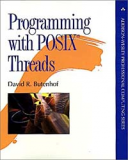Книга: Programming with POSIX® Threads
6.3 Process exit
6.3 Process exit
In a nonthreaded program, an explicit call to the exit function has the same effect as returning from the program's main function. The process exits. Pthreads adds the pthread_exit function, which can be used to cause a single thread to exit while the process continues. In a threaded program, therefore, you call exit when you want the process to exit, or pthread_exit when you want only the calling thread to exit.
In a threaded program, main is effectively the "thread start function" for the process's initial thread. Although returning from the start function of any other thread terminates that thread just as if it had called pthread_exit, returning from main terminates the process. All memory (and threads) associated with the process evaporate. Threads do not run cleanup handlers or thread-specific data destructors. Calling exit has the same effect.
When you don't want to make use of the initial thread or make it wait for other threads to complete, you can exit from main by calling pthread_exit rather than by returning or calling exit. Calling pthread_exit from main will terminate the initial thread without affecting the other threads in the process, allowing them to continue and complete normally.
The exit function provides a simple way to shut down the entire process. For example, if a thread determines that data has been severely corrupted by some error, it may be dangerous to allow the program to continue to operate on the data. When the program is somehow broken, it might be dangerous to attempt to shut down the application threads cleanly. In that case, you might call exit to stop all processing immediately.
- Entering and Exiting PHP Mode
- 7.2.3. Image Complexity
- Introduction to Microprocessors and Microcontrollers
- Using the kill Command to Control Processes
- 1. Basic microprocessor systems
- The DISPLAY Processor
- Beginning the Boot Loading Process
- Background Processing
- Graphical Process and System Management Tools
- KDE Process- and System-Monitoring Tools
- Apache Multiprocessing Modules
- ACID Compliance in Transaction Processing to Protect Data Integrity




